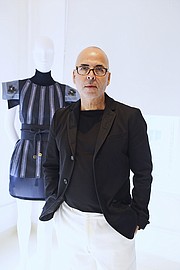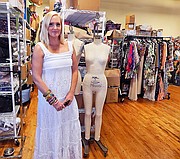MANUFACTURING
What’s at Stake if a Designer’s Name is Part of the Label?
The name game can be a financially dangerous game played by designers every time they create a new label.
Designers constantly weigh whether to use their own name and risk losing the commercial use of that name if financial backers take over or invent a catchy label name they hope hasn’t been used before.
The decision is crucial and can mean the difference between success or failure, as experienced by many Los Angeles designers.
“The Los Angeles garment scene is littered with the tragic stories of celebrated designers who lost the right to use their personal names in their chosen business,” said Greg Weisman, an attorney and partner with Ritholz Levy Sanders Chidekel & Fields, who works with a number of apparel companies in Southern California. “Unless a designer is independently wealthy and can self fund his or her venture, including all production growth indefinitely, at some point in the business lifecycle they will need to borrow money from another.”
And that is where the inherent danger lies for creative types. Paul Frank Sunich, who created the iconic Julius the Monkey image, which took off and became a popular mainstay in many people’s wardrobe, lost the right to commercially use his name after he left Paul Frank Industries. When he tried to use his name in another venture, his business partners in Paul Frank Industries sued him for trademark infringement. A U.S. District Court judge ruled Sunich couldn’t use his name for commercial purposes.
Six years ago, Haim Saban Industries in Los Angeles acquired Paul Frank Industries for $50 million. In an unusual twist, the new owners hired Paul Sunich early this year as director of creative development of a company that owns his trademarked name.
Louis Verdad, the popular Los Angeles designer who recently showed his new Verdad line at New York Fashion Week, lost the right to use his name in his label after a 2007 bankruptcy. His factors, American Business Fund, sued him in court, saying they had advanced him $163,000 in production funds and that Verdad had used his label’s name as collateral.
In the end, the factors ended up owning the Louis Verdad label and its commercial use. To move forward, the Los Angeles designer, who was very popular with celebrity stylists and had dressed Madonna, went on to create a new label called Louver (LOUis VERdad).
But nearly four years ago, he regained the use of his self-named label with the help of Los Angeles law firm Munger, Tolles & Olson, which took on his intellectual-property case on a pro bono basis.
“It was a fight,” Verdad said from his Los Angeles home. “We had to go to court.”
Meanwhile, American Business Fund sold the intellectual rights to Louis Verdad’s name in China, where there are several Louis Verdad stores.
Now the designer is working to build up his new Verdad label, which is a modern contemporary line that sells for $700 to $1,200 and incorporates high-end denim as the principal fabric. A Louis Verdad label, with higher price points, is in the making.
Los Angeles designer Meghan Noland had a similar experience 14 years ago as a newbie to the fashion scene. Her business partner, Peter Ma, ended up owning her Meghan Noland label after he financed production and claimed the line was unprofitable even though it had been selling at Nordstrom, Bloomingdale’s and Harvey Nichols.
Lawsuits went back and forth until Noland realized she couldn’t afford the legal fees and walked away from her brand. “When I split from him, I had to rebrand myself and I couldn’t [commercially] use my last name any more,” she said from her design studio near downtown Los Angeles. “There were some really great stores I was selling. I needed to figure out a new strategy.”
So Noland created the Meghan Fabulous line, which sold on the QVC network. She even started introducing herself to new acquaintances as Meghan Fabulous because she didn’t want to promote the old line that bore her name.
Later she started the Meghan Los Angeles brand, which has the glamorous bohemian vibe for which she is known and is sold at Nordstrom,Hautelook.com and Poshmark.com.
When her old business partner shut down his venture and let the Meghan Noland trademark lapse, she bought it back. But she is still uncertain about whether to revive it. “When I first got into this business, I always wanted to have a brand and own my own business,” she said. “Maybe I used my own name for my own ego and to let people know this brand is me. But I feel if I knew what I know now, I would have done things so much differently. It would have been more about the clothes and not my name.”
Keeping it safe
Several attorneys say there are pros and cons to using a designer’s name in the label. “Some people use their name because they are a well-known designer like Yves St. Laurent or Calvin Klein and it helps sales,” said Eric Galen, an attorney who handles intellectual property at the Los Angeles office of Greenberg Glusker. “But if you are an unknown designer, for gods sake don’t name the company after yourself because at the end of the day it’s not going to be worth more because of your name. … When you start creating a legal entity, the thing of value will be linked to your name and that can be very complicated.”
If a designer is very successful, there is a lot of money that can be made by selling his or her label. But there are pitfalls. Galen points to designers like Kate Spade, who sold her label to Liz Claiborne, which renamed its entire business venture Kate Spade. “Now the real Kate Spade must rebrand herself as she no longer owns the rights to her own name,” he noted, saying she designs under the label Frances Valentine, which is the name of her daughter. “Kate Spade can no longer [commercially] use the name Kate Spade.”
Even using variations of your name in business may not be possible. Joseph Abboud, who sold his brand name for $65 million in 2000, decided seven years later, after his noncompete period was over, to create a new line called Jaz.
But the owner of the Joseph Abboud trademark, JA Apparel Inc., said the Jaz tagline, “A new composition by designer Joseph Abboud,” was confusing to consumers.
The Jaz label made it to store shelves but without the mention of Joseph Abboud. In 2012, Men’s Wearhouse, where Abboud is the chief creative director, bought back the Joseph Abboud trademark for $97.5 million, reuniting the designer with his namesake label.
Attorney Weisman advised designers to be cognizant of the consequences when creating a self-named label. “If you are going to choose an eponymous name for your brand, know the risks of losing it are there. Understand that your name as a trademark can be owned by another party and they can sell it on the open market, take it to Costco or simply run it into the ground,” he said.
If you want to make sure you keep your name for commercial use, Galen advised not using it in a brand name. “If you do use your name in the brand and sell it, you can try to negotiate the right to use it, but that is very hard,” he noted. “You could license it back or you can sell your name for X amount of years. All of these things are negotiable.”























